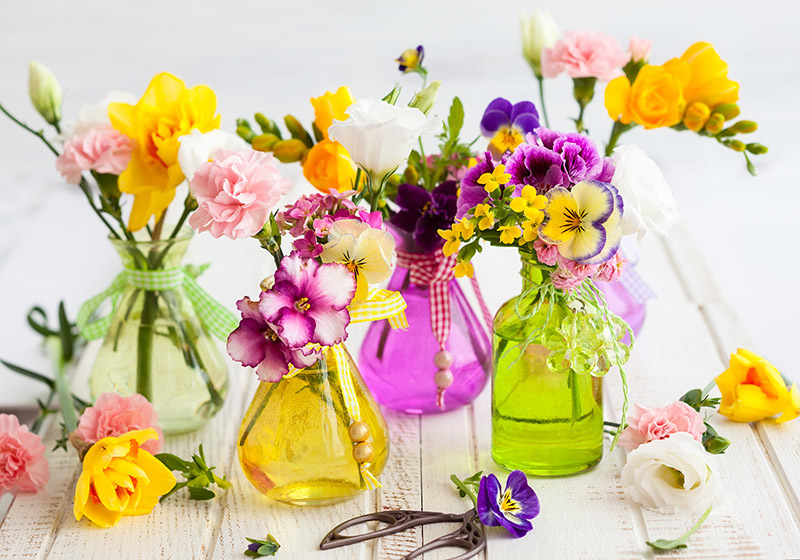Discover Your Birth Flower and Uncover Its Hidden Meaning
Posted on 25/08/2025
Discover Your Birth Flower and Uncover Its Hidden Meaning
Have you ever wondered what your birth flower is and what it reveals about you? Just as everyone has a unique birthstone, each person also has a special flower associated with their birth month. These blossoms carry rich symbolism and hidden meanings that can offer insight into your personality, relationships, and even your destiny.
In this extensive guide, we'll take you on a fascinating journey to discover your birth flower and uncover its secrets. Explore the history, symbolism, and cultural significance behind every month's flower, and learn how to embrace its positive energy in your own life.

What is a Birth Flower?
Birth flowers are specific blooms assigned to each month of the year, much like zodiac signs or gemstones. Originating from ancient traditions, birth month flowers are believed to represent not only the time of the year but also key attributes and traits of individuals born in that month.
- January: Carnation
- February: Violet & Primrose
- March: Daffodil & Jonquil
- April: Daisy & Sweet Pea
- May: Lily of the Valley & Hawthorn
- June: Rose & Honeysuckle
- July: Larkspur & Water Lily
- August: Gladiolus & Poppy
- September: Aster & Morning Glory
- October: Marigold & Cosmos
- November: Chrysanthemum
- December: Narcissus & Holly
Let's dive deeper into each month to discover your birth month flower meaning and how it can inspire you.
January Birth Flower: Carnation
Carnation - The Emblem of Admiration and Love
People born in January are represented by the vibrant Carnation. Known for its ruffled appearance and sweet fragrance, the carnation symbolizes love, fascination, and distinction.
- Color Meanings: Red carnations reflect deep love, while white stands for pure affection and remembrance.
- Hidden Meaning: Carnation also denotes loyalty and gratitude, making January-born folks loyal friends and cherished companions.
February Birth Flower: Violet & Primrose
Violet - Humility and Faithfulness
The delicate Violet carries connotations of modesty, faithfulness, and spiritual wisdom. In Victorian times, violets symbolized secret love and devotion.
- Violet's deep purple is associated with royalty and dignity.
- February's chilly climate matches the violet's resilience and grace.
Primrose - First Love
The Primrose blooms at winter's end, signifying youthful love and renewal. Giving primroses traditionally means, "I can't live without you."
March: Daffodil & Jonquil
Daffodil - Hope and Rebirth
March's Daffodil is a bright herald of spring, symbolizing new beginnings, hope, and rejuvenation.
- Gift a bunch: Presenting daffodils in a bunch (not singly) brings happiness and good fortune.
- Personal growth: March-born individuals often embody optimism, renewal, and creativity.
April: Daisy & Sweet Pea
Daisy - Innocence and Purity
April's Daisy stands for childlike purity, innocence, and loyal love. Daisies are also connected to new starts and true friendship.
- Linked to Norse mythology's Freya, goddess of love and fertility.
- April-born individuals are often cheerful, optimistic, and trustworthy.
Sweet Pea - Bliss and Farewell
The Sweet Pea expresses gratitude, pleasure, and the bittersweetness of goodbyes. Sweet peas make lovely gifts to those embarking on a new journey.
May: Lily of the Valley & Hawthorn
Lily of the Valley - Happiness and Humility
May's Lily of the Valley represents sweetness, humility, and the return of happiness. Its dainty bell-shaped blooms mark the arrival of spring and fresh opportunities.
- Frequently associated with weddings and new beginnings.
- The scent is said to bring luck in love and prosperity.
Hawthorn - Hope and Fertility
The Hawthorn flower symbolizes hope, fertility, and protection. In folklore, it's believed to guard against negative energy and nurture lasting relationships.
June: Rose & Honeysuckle
Rose - Love and Passion
June is adorned with the classic Rose, the universal emblem of love, passion, and beauty. With its myriad of colors, each rose shade tells its own story.
- Red: True love and desire
- Pink: Admiration and joy
- White: Purity and remembrance
- Yellow: Friendship and cheer
Roman and Greek mythology connects roses to Venus and Aphrodite, making June-born people naturally romantic and creative.
Honeysuckle - Devotion
The Honeysuckle embodies enduring devotion and lasting bonds, reinforcing June-born individuals' reputation for loyalty and warmth.
July: Larkspur & Water Lily
Larkspur - Positivity and Levity
With dazzling colors, the Larkspur stands for open-heartedness, positivity, and lightness of being.
- Purple: Represents first love
- Blue: Grace and dignity
- Pink: Fickleness
Water Lily - Purity of Heart
The Water Lily, floating serenely on ponds, signifies purity, peace, and enlightenment. July-born are often known for their gentle, nurturing spirits.
August: Gladiolus & Poppy
Gladiolus - Strength and Integrity
August's Gladiolus is a dramatic flower symbolizing strength of character, integrity, and determination.
- Named after the Latin word "gladius," meaning sword, for its striking shape.
- August-born are often courageous, determined, and honest.
Poppy - Imagination and Remembrance
The Poppy stands for imagination, remembrance, and consolation. In some cultures, red poppies are offered to honor the memory of loved ones.
September: Aster & Morning Glory
Aster - Wisdom and Valor
The star-shaped Aster represents wisdom, valor, and faith. Asters are also associated with elegance and patience.
- Commonly linked with Venus, the goddess of love.
- September-born are seen as wise, dependable, and kind-hearted.
Morning Glory - Affection
The Morning Glory symbolizes affection, love in vain, and the fleeting nature of time, as its blooms last but a single day.
October: Marigold & Cosmos
Marigold - Passion and Creativity
Bright and bold, the Marigold is a flower of creative passion, warmth, and joyousness. In some cultures, marigolds are cherished for honoring loved ones who have passed.
- Represents October-born's vibrant, confident spirit.
- Associated with offerings and celebration during Dia de los Muertos.
Cosmos - Harmony
The Cosmos flower's simple beauty embodies order, peace, and harmony with nature, highlighting October-born individuals' gentle energy.
November Birth Flower: Chrysanthemum
Chrysanthemum - Loyalty and Friendship
The Chrysanthemum blooms when most other flowers have faded, thus representing loyalty, long life, and enduring friendship. In Asia, "mums" are seen as harbingers of joy and celebration.
- Red Chrysanthemum: Love
- White Chrysanthemum: Truth and loyalty
- Yellow Chrysanthemum: Unrequited love
December: Narcissus & Holly
Narcissus - Good Wishes and Renewal
December babies are honored by the Narcissus (paperwhite daffodil), signifying good fortune, hope, and renewal. In Chinese culture, the narcissus heralds prosperity for the coming year.
Holly - Protection
The festive Holly with its vibrant red berries is a symbol of protection, defense, and goodwill. Holly plants are often used to safeguard homes and celebrate the spirit of winter.
How to Incorporate Your Birth Flower Into Your Life
Knowing your birth month flower and its meaning offers many practical and symbolic uses in everyday life. Here are a few inspiring ways:
- Home Decor: Adorn your living spaces with fresh or faux birth flowers to surround yourself with their positive energy and symbolism.
- Personal Heirlooms: Jewelry, charms, or tattoos featuring your flower can serve as a personal emblem and conversation piece.
- Gift Ideas: Giving someone their birth flower is a thoughtful gesture, perfect for birthdays, anniversaries, or just because.
- Garden Inspiration: Plant your birth flower in the garden or a pot to invite its meaning of luck, love, or protection into your life.
- Meditation and Journaling: Reflect upon your flower's message during meditation or write about it in your journal to inspire personal growth.

Unlock the Wisdom of Birth Flowers
Discovering your birth flower and embracing its hidden meaning is a unique way to connect with yourself and nature's cycles. Whether you seek love, protection, strength, or renewal, your birth flower holds a potent message tailored just for you.
Next time you celebrate a birthday - your own or a loved one's - share the meaningful story of that month's flower. You might just deepen your connections and spark new inspiration in the process.
Frequently Asked Questions About Birth Flowers
- Can I have more than one birth flower?
Yes! Many months, like February, March, and April, have two associated flowers due to regional and cultural variations. - What if my favorite flower isn't my birth flower?
You can enjoy the symbolism of any flower, but your birth flower carries an extra layer of personal meaning based on age-old tradition. - How accurate are flower meanings?
Traditional meanings provide a poetic guide, but your connection to your flower matters most.
In Conclusion: Celebrate Your Unique Flourish
By learning about and honoring your birth flower, you connect to a living tradition of symbolism, beauty, and self-discovery. Embrace your personal birth bloom's qualities, let its positive message inspire you every day, and share this floral wisdom with those you care about.
Remember - your birth flower isn't just a symbol. It's a celebration of the essence that makes you uniquely you.
Latest Posts
Discover Your Birth Flower and Uncover Its Hidden Meaning
Discover the Top 12 Long-Lasting Blooms
Exploring the Symbolism Behind Peony Flowers and Their Colors





